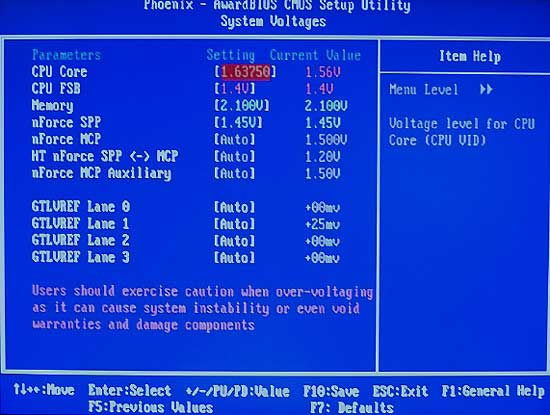7 - NVBIOS
NV BIOS Features
Physically the BIOS features have not changed a lot ever since 680i was released. Linkboost is a thing of the past though and you'll findx some new features to accommodate Penryn (45nm) processor's power saving functions. The 790i BIOS however will give you the ability to control anything. Including a very wide range of frequencies, multipliers, and voltages, so users would have no trouble to adjust settings manually.

Also please notice the new GTLVREF Voltage setting
I'll replicate NVIDIA's explanation here, but GTLVREF is used to adjust the input sample trigger point on Intel CPUs. Adjustments to this value can compensate for voltage drops that occur for some loading and traces. For example, GTLVREF can be lowered to account for voltage drops when tuning a Kentsfield CPU instead of a Conroe CPU.
Kentsfield CPUs typically put more loading on key interface signals which results in the average interface voltage drop. GTLVREF is a fine tuning device that can enable higher frequency for some interfaces. A Kentsfield CPU needs two GTLVREF voltage settings; one is for the 4x signal (for FSB data transfer), and the other is for 2x/1x signal (for FSB addressing, control).
- GTLVREF0 -> FSB 4x data signal on core 0
- GTLVREF2 -> FSB 2x/1x address signal on core 0
- GTLVREF1 -> FSB 4x data on core 1
- GTLVREF3 -> FSB 2x/1x address signal on core 1
A newly added feature in voltage selection are color codes, green is good, red is entering a danger zone.
- The CPU VID voltage can be adjusted for a LARGE range 25mV increments up-to 1.8 Volts for our Core 2 Duo/Quad processors.
- The Memory voltage can be adjusted from 2.275V in 25mV increments.
- The HT CPU to nForce SPP voltage can be adjusted from 1.225V to 1.4V in 25mV increments.
- The HT nForce SPP to MCP voltage can be adjusted from 1.325V to 1.55V in 25mV increments.
- The nForce SPP voltage can be adjusted from 1.25V to 1.55V in 50mV increments.
- The nForce MCP voltage can be adjusted from 1.525V to 1.75V in 25mV increments.
To fine-tune for stability you can change out the HTT Link Multipliers (1x to 5x), both for upstream and down stream, so that you do not push the Hyper Transport speed way out of stability while adjusting the base reference clocks.
And so on. Obviously you can auto-overclock with SLI-OC functions in combo with SLI (EPP 2.0) memory. The lovely Memory Expert mode allows the memory timings to be adjusted for best performance. Set these as low as possible to achieve the best benchmark scores. Along with the memory speed setting, the following parameters have the most influence on system performance:
- Tcl (CAS Latency)
- Trcd(RAS to CAS Delay)
- Trp (Row Precharge)
- Tras (Active-to-Precharge Delay)
- Addressing Mode 1T/2T (Command Per Clock)
- MaxAsyncLatency
Almost forgot it, but with the latest BIOS we received, we were able to take the FSB 2800 MHZ! Yeah, we failed miserably, but it's good to know it's possible. We'd really need liquid nitroglycerine (Ed: explosive overclocking - the next big thing :) for such an overclock man.
There are many more features, functions and settings we can discuss. Pretty much anything you need for a good tweak can be found and set to the maximum. You can really go nuts in there from the average to the advanced user. Hell you can even switch off one core of your processor if you want to and I have not even mentioned the advanced monitoring tools which in it's end can be monitored and altered from within Windows as well with the help of nTune.
Strangely enough no ESA functions can be found in the BIOS. It would have been nice; for example to set the water-cooling pump speed in the BIOS prior to booting into Windows.
